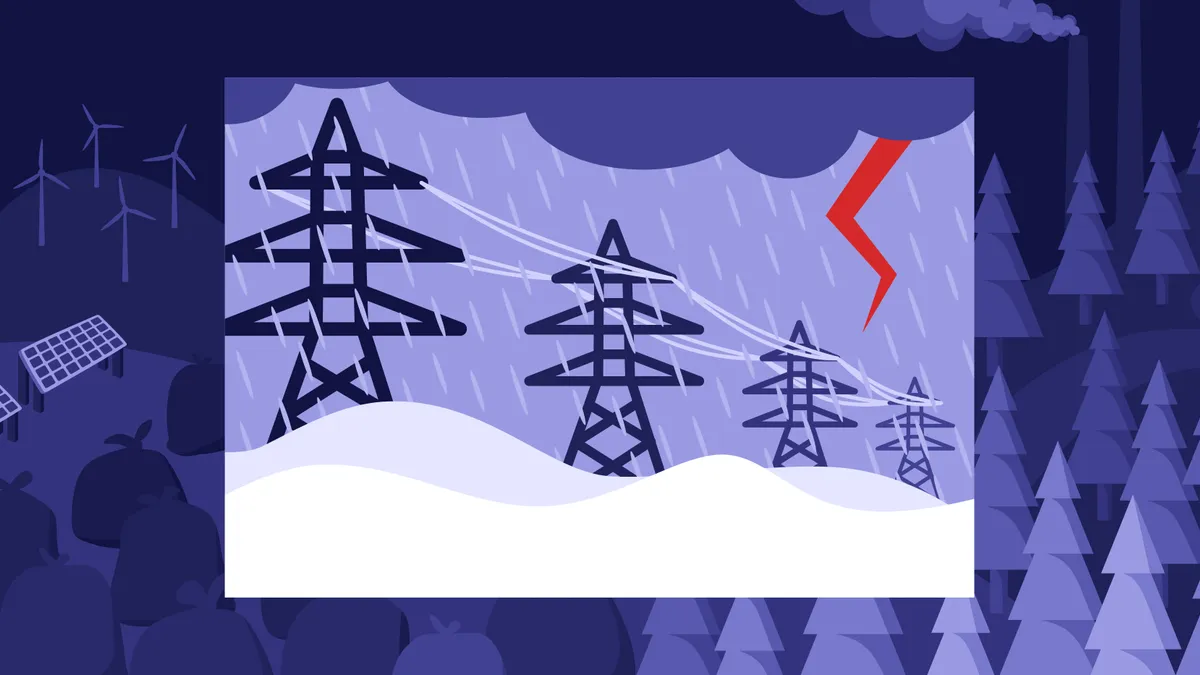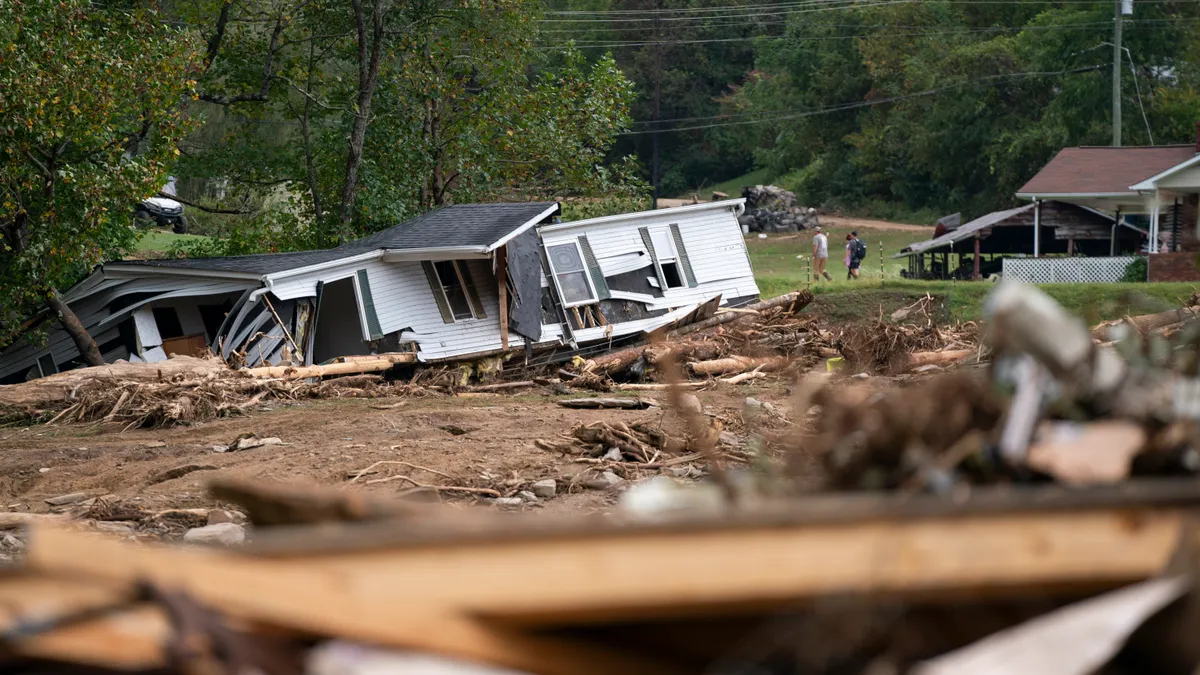As rolling outages continued to plague Texas on Wednesday, power sector experts found themselves fighting against misinformation about the root of the problem.
Texas Gov. Greg Abbott, R, and Rep. Dan Crenshaw, R, were quick to blame renewable energy, particularly wind, for causing the supply constraints the region has been facing since Sunday evening.
"This shows how the Green New Deal would be a deadly deal for the United States of America," Abbott said in an interview on Fox News. "Texas is blessed with multiple sources of energy, such as natural gas and oil and nuclear, as well as solar and wind. But ... our wind and our solar that got shut down ... thrust Texas into a situation where it was lacking power [on] a statewide basis."
But data from the state's grid operator makes it clear that the majority of outages were caused by gas supply constraints corresponding to a major spike in demand. Though no power resource performed perfectly, power sector experts dismissed the idea that renewables alone were to blame for the outages.
Many questions remain, however, on whether grid operators in Texas were prepared, how generators could have better planned for such extreme weather, how they might in the future and whether future rolling blackouts can be minimized.
"The fact that this was not wind's fault is not an argument that the wind system as we currently have it would have done better if it were a bigger part of the grid," said Emily Grubert, assistant professor of civil and environmental engineering at Georgia Tech. "It's an argument that we need to be more prepared for emergency situations. It's an argument that we need to think about how we're designing a grid that is probably going to be subjected to more extremes than it has been in the past for climate change reasons, in particular. It's not really a fuel thing. It's a grid design thing."
What caused the outages?
The Electric Reliability Council of Texas (ERCOT) triggered rolling blackouts Sunday evening after a simultaneous spike in demand and drop in supply shocked its system. An uneven supply/demand balance bolstered by fuel delivery and power plant operational problems, has continued to prevent the grid operator from returning full power to customers this week.
Last Thursday, ERCOT issued a news release warning that it may face "record" electricity usage due to an incoming winter snow storm, caused by a polar vortex, and urged generators to review fuel supplies and planned outages in preparation for the weather. By Sunday, ERCOT was urging ratepayers to reduce power usage due to record demand and "higher-than-normal generation outages," due to frozen wind turbines and limited gas supplies.
On Wednesday, Dan Woodfin, ERCOT senior director of system operations clarified that "significantly" more MW of thermal generation were offline than renewables — at 28,000 MW, versus roughly a third of the 18,000 MW of wind capacity expected. Though ERCOT has not broken down thermal generation by source, the majority of its winter peaking capacity relies on gas, and most of the thermal issues were tied to frozen gas wells and pipelines, plus one nuclear reactor outage Monday, accounting for around 1,300 MW of the thermal outages.
"There was an enormous amount of electric generation ... that was taken out of service by the storm," ERCOT CEO Bill Magness told reporters Wednesday, causing wind turbines, gas pipelines, gas wells and other essential equipment to freeze, as well as the grid operator to call for outages in order to avoid "catastrophic blackouts" with an "indeterminate end date."
Ultimately, the grid operator was responding to a peak demand of 69,150 MW on Sunday, significantly above its projected peak of 57,699 MW for this winter season, as well as its previous peak record of 65,915 set in January 2018. Meanwhile, ERCOT's "extreme" outage scenario predicted a peak of 13,953 MW of thermal outages, which was more than doubled Sunday.
"That is where the disaster is stemming from," said Jesse Jenkins, an assistant professor and energy systems engineering at Princeton University, in a tweet, adding wind's underperformance was "secondary." Wind and solar resources fluctuated roughly 4,000 MW to 5,000 MW below what was projected of them at a time, but wind and solar also regularly exceeded the 6,200 MW that was expected of them, Jenkins found in examining ERCOT data.
"Main story continues to be the failure of thermal power plants — natural gas, coal, and nuclear plants — which ERCOT counts on to be there when needed," he said. "They've failed. Of about 70,000 MW of thermal plants in ERCOT, ~25-30,000 MW have been out since Sunday night. Huge problem."
Part of the issue was also a lack of winterization for generating resources, based on Texas' typical climate, noted ERCOT officials. Generators in those colder climates generally invest in various de-icing measures to ensure wind farms operate at maximum capacity during the winter months. But individual generators might not be willing to invest in the same winterization protections in a warmer state like Texas. The same goes for thermal power plants — facilities are often built without walls in southern climates to maximize efficiency and prevent units from overheating in the hotter summer months, but leaving plants more vulnerable to cold weather.
This is in part why all resources struggled through this storm, said Woodfin.
"In different ways, the very cold weather and snow and those kinds of things impacted every type of generator," he said.
How should grid operators prepare for 'unprecedented' weather?
Part of the challenge in planning for outages as widespread as those ERCOT experienced this week is that grid operators tend to prepare for winter and summer peak loads based on historical data, but those forecasts won't work as weather becomes less predictable under a changing climate, said Michael Craig, assistant professor of energy systems at the University of Michigan.
"If you're planning for historic events ... that is not going to be good enough," he said. "And we thought [planning for historic events] would not be good enough, five, or 10, or 15 years down the line. But we are quickly realizing ... with California this summer and other events, that it's not really good enough right now."
A record-breaking heat wave in California this summer created a spike in demand that met lower-than-expected generation and constrained power imports, forcing the state's grid operator to trigger rolling blackouts. Across Texas this past week, winter weather was the coldest it had been in decades, prompting different generation issues, but ultimately similar outcomes: rolling blackouts in the midst of extreme weather.
"What we saw this week is a historic, unprecedented weather event that took the demand side of the grid balance equation to skyrocket," Magness told reporters on Tuesday, adding the events "basically shattered" ERCOT's prior winter record.
"We saw ... more demand than we've ever seen in the winter and almost as much as we see at the peak of our summer," he said.
Such extreme temperatures are difficult to plan for, said Craig. "We could spend billions and billions of dollars and make sure that we're fine. But we don't want to waste money," he said. "We don't want to overspend because those costs are going to be borne either by private investors, or, in many, many markets by ratepayers." The key is balancing reliability while not overspending, he said, but "that balancing act is really complicated by climate change."
Further, breaking down system failures by generation source really misses the point when considering broader planning, said Grubert. Although gas was the primary culprit this time, in Texas and California, "the major, major systems that are the majority of the grid in both cases also struggled under these circumstances," she said. "Recognizing that the conditions that we see here are going to cause basically any system to struggle is an important thing to be aware of, and is an important thing to be planning around."
In 2011, Texas also had "unusual" cold weather, wherein 210 generators across the state experienced an outage or failed to start, triggering a load shed of over 5,000 MW over the course of three days. The instances led to a federal inquiry by the North American Electric Reliability Corporation (NERC) and Federal Energy Regulatory Commission (FERC).
Ultimately, NERC adapted its suggested "best practices" into a non-mandatory "guideline" for generators, according to Woodfin. Generators in ERCOT file their weatherization plans with the Public Utility Commission of Texas, and ERCOT does regular "spot checks" on about 100 of the approximately 600 units within its footprint to ensure those best practices are being implemented.
In cold weather events experienced in the region since then, those practices have worked, Woodfin said, "but as even more extreme cold weather events that happened the last few days occurred, apparently, those [practices] were not sufficient to keep these generators online."
FERC and NERC announced they would again open an inquiry into the impacted regions, which include the footprints of the Southwest Power Pool and Midcontinent Independent System Operator as well.
"In the days ahead, we will be examining the root causes of these reliability events," said FERC Chair Richard Glick in a statement "but, for now, the focus must remain on restoring power as quickly as possible and keeping people safe during this incredibly challenging situation."
The human toll
Almost 2.4 million Texans remained without power as of Wednesday night, and about 500,000 as of Thursday morning, according to PowerOutage.US, following a peak of almost 4.5 million customers in the state. At least 17 deaths were attributed to the storm and successive power outages as of Wednesday night, the Weather Channel reported.
In considering ERCOT's and the power system's response at large, it's easy to miss the human element of system planning, said Grubert, namely ensuring people are safe.
"I think, to some extent, asking questions about 'How could we make sure that the power didn't go out?' is the wrong question, relative to 'How do we make sure that people actually still had access to safe temperatures in an event like this?'" she said. "Part of the answer to that question might be 'Don't let the power grid go down.' But to focus purely on keeping the power grid up, I think, goes the wrong direction in a couple of ways."
Extreme events are difficult to plan for and replicate, she said, particularly as weather patterns change and become more variable. "The other really big, important piece of this conversation is that even if the power hadn't [gone] out, a lot of people would have been really, really, very exposed to pretty dangerous conditions."
As of Wednesday afternoon, ERCOT was continuing to shed 14,000 MW of load in order to prevent "catastrophic blackouts" with an "indeterminate end date," according to Magness. ERCOT was unable to provide an estimated timeline on when things would return to normal, but officials said they would not be able to stop the outages until supply and demand are back in balance.
"We've been working to get that balance back so we can operate the system reliably and safely going forward. And unfortunately, that has caused us to maintain a lot of these outages much longer than anyone would want," Magness said. "The horrible consequences of what's happened with that are obvious. Very cold time, some of the coldest weather we've seen in Texas, and people not having power is dangerous. The essential nature of this service is very obvious when we have issues like this."





















